Choosing the Optimal Tarp Material for Farming
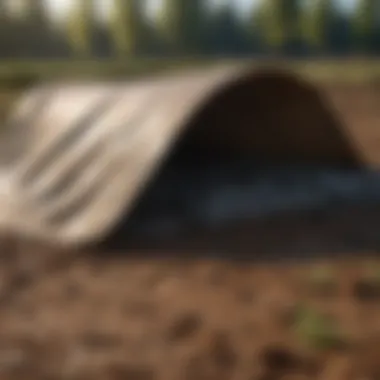
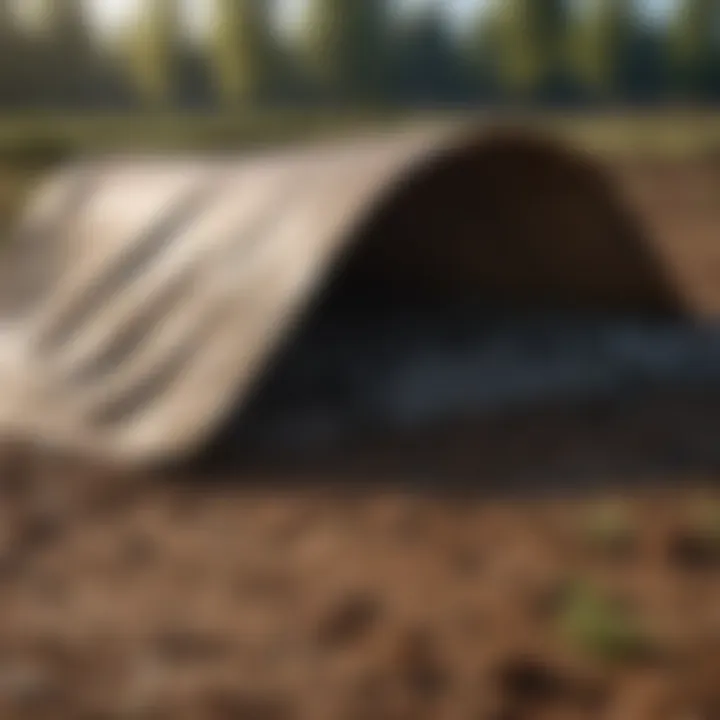
Intro
In agriculture, selecting the right tarp material is crucial for effective crop management. Farmers and enthusiasts must consider various factors such as durability, light transmission, and water resistance when choosing tarps. As agricultural practices evolve, so do the materials available. Understanding these options can significantly impact crop yield and sustainability.
Topic Overview
Definition and Importance
Tarps, or tarpaulins, serve multiple purposes in agricultural settings. They can provide protection against harsh weather, prevent soil erosion, and facilitate better temperature management for crops. The importance of adopting the appropriate tarp material cannot be understated. Inappropriate materials can lead to crop damage and increased costs. Hence, evaluating tarp properties like UV resistance, weight, and breathability is essential for sustaining agricultural productivity.
Brief History and Evolution
Historically, tarps have been made from natural fibers like cotton or hemp. With modern advancements, synthetic materials like polyethylene and PVC have become prevalent due to their durability and versatility. Over the years, innovations in material technology have allowed for the development of specialized tarps designed for specific agricultural needs, enhancing their effectiveness in crop protection and resource conservation.
Key Techniques and Innovations
Sustainable Farming Practices
Using appropriate tarp materials aligns with sustainable farming principles. For instance, biodegradable tarps made from plant-based polymers are gaining traction. These materials reduce plastic waste while still providing the necessary protection for crops. By selecting eco-friendly tarps, farmers can contribute to the overall health of their farming ecosystems.
Advanced Agronomic Technologies
The integration of technology in agriculture has also influenced tarp selection. Smart tarps embedded with sensors can monitor soil moisture and weather conditions. This data helps farmers decide when to cover crops and when to let them breathe, optimizing growth conditions and minimizing resource use.
Practical Applications
Step-by-Step Guides
- Assess Your Needs: Determine the primary function your tarp will serve—sun protection, water retention, or frost prevention.
- Evaluate Material Options: Research properties of different materials like polyethylene, canvas, and fabric films to find the best fit for your agricultural environment.
- Consider Climate Conditions: Adapt your tarp choice based on your local climate. A UV-resistant tarp may be necessary in areas with high sunlight exposure.
- Implement and Monitor: Install your selected tarp and monitor its effectiveness. Adjust your usage based on crop response and changing weather conditions.
Case Studies or Real-World Examples
A notable case involves the use of a UV-resistant polyethylene tarp in California's almond orchards. Farmers who implemented this tarp reported a notable increase in yield due to better light management and reduced water evaporation. In contrast, those using traditional materials experienced lower crop health and higher irrigation costs. This example illustrates the practical benefit of aligning tarp selection with agricultural goals.
"The right tarp not only protects crops but enhances their growth potential. The science behind material selection is crucial for sustainable practices."
By understanding the properties of different tarp materials and their applications in agriculture, farmers can make informed decisions to improve crop resilience and sustainability.


Intro to Tarp Materials
In the realm of agriculture, tarps serve a crucial role in safeguarding crops and enhancing productivity. Understanding the fundamentals of tarp materials equips farmers with the necessary knowledge to choose the right type for specific agricultural applications. This section delves deep into the significance of tarps, their definitions, and their vital importance in agricultural practices.
Definition of Tarps
Tarps, or tarpaulins, are durable sheets made from various materials, designed to provide protection against environmental factors. They can be made from polyethylene, PVC, canvas, and other fabrics. Tarps are often waterproof, UV resistant, and capable of withstanding harsh weather conditions. Farmers frequently utilize these materials for covering structures, protecting crops, and managing resources in the field. The versatility of tarps makes them indispensable in agricultural settings.
Importance of Tarps in Agriculture
Tarps offer several advantages that are essential for successful farming operations:
- Crop Protection: Tarps help shield crops from excessive sunlight, rain, and pests. This contributes to healthier growth and higher yields.
- Soil Management: Covering soil with tarps can prevent erosion, keep moisture in, and suppress weeds. This is vital for maintaining soil health and reducing competition for nutrients.
- Resource Conservation: By using tarps, farmers can effectively manage irrigation and protect valuable resources from evaporation or contamination.
"Proper tarp usage can improve crop yields while minimizing resource waste."
Overview of Common Tarp Materials
Understanding the various tarp materials available is crucial for agricultural applications. Each material comes with unique properties, advantages, and drawbacks that can significantly impact their performance in specific farming environments. By evaluating the common tarp materials, farmers can make informed decisions that maximize crop protection and efficiency. This section unpacks several key materials that are prevalent in agricultural settings.
Polyethylene (PE) Tarps
Polyethylene tarps are widely used in agriculture due to their lightweight and durable nature. They are made from high-density polyethylene, making them resistant to tearing, UV rays, and water. PE tarps also come in various thicknesses, allowing farmers to select the appropriate option based on individual needs.
One of the main benefits of PE tarps is their affordability. They offer a cost-effective solution for temporary applications, such as covering crops during inclement weather. However, these tarps may have a shorter lifespan compared to other materials. They can degrade faster under prolonged exposure to sunlight and heavy rain.
Polyvinyl Chloride (PVC) Tarps
Polyvinyl Chloride tarps are known for their robustness and versatility. PVC tarps are thicker and stronger than PE tarps, making them ideal for long-term applications in agricultural settings. Their excellent water resistance shields crops from heavy rain. Additionally, they have fire-retardant properties, which adds an extra layer of safety in farms that use varying agricultural burns.
Despite their advantages, PVC tarps can be heavier and more expensive than their PE counterparts. Farmers must weigh the costs against the benefits when selecting these tarps.
Canvas Tarps
Canvas tarps are another popular choice among farmers. Made from woven cotton or a cotton-polyester blend, these tarps offer excellent breathability. This property makes them suitable for protecting crops that require ventilation. Canvas tarps are thick and durable, providing good resistance against abrasion and wear.
However, they are not as water-resistant as synthetic options. Farmers may need to treat canvas tarps with additional coatings to enhance their water repellency. The weight of canvas tarps can also be a drawback for easy transport or setup.
Fabric Tarps
Fabric tarps comprise various synthetic fibers, such as polypropylene and polyester. They offer a balance between strength, flexibility, and weight, making them adaptable for several agricultural operations. These tarps are typically lighter than canvas tarps, which increases portability.
Fabric tarps are often designed with features like multiple grommets for easy securing and attachment. They can also come with UV protection, adding to their durability in harsh environments.
While fabric tarps can provide good coverage, they may not always offer the same level of water resistance as PVC or heavy-duty PE tarps. Farmers should assess their specific needs to determine if fabric tarps are suitable for their application.
In summary, each tarp material has distinct characteristics that appeal to different farming needs. Understanding these options helps farmers select the right tarp material, enhancing agricultural productivity.
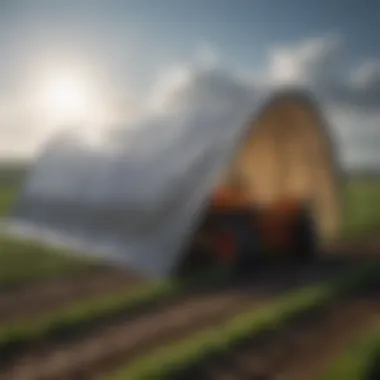

Evaluating Tarp Materials for Agricultural Use
Evaluating tarp materials for agricultural use is critical for maximizing productivity and protecting crops. The choice of tarp can significantly impact farming operations, influencing efficiency and the effectiveness of crop protection. This assessment involves considering various factors such as durability, water resistance, weight, and ease of installation. By understanding these elements, farmers can make informed decisions that suit their specific needs.
Durability and Longevity
When selecting a tarp, durability is a major consideration. Agricultural environments can be harsh, with exposure to extreme weather, UV rays, and abrasives from the soil. A durable tarp can withstand these conditions and offers a longer lifespan. Polyethylene tarps, for example, are known for their resistance to tearing and weather-related wear. They can last multiple seasons, minimizing the need for frequent replacements. In contrast, canvas tarps may offer durability but are often heavier and can absorb water, which may lead to mildew over time. Emphasizing longevity helps reduce waste and lowers overall agricultural costs.
Water Resistance and Protection
Water resistance is another essential factor in evaluating tarp materials. It is vital to protect crops from rainwater and excess moisture. Tarps that are not waterproof can lead to water pooling, which may promote fungal growth and affect crop health. Polyvinyl chloride (PVC) tarps offer excellent water-resistant properties, making them suitable for areas with high rainfall. Proper water protection ensures crops remain healthy and productive. Farmers should also consider how water resistance affects air circulation under the tarp. A good tarp should provide a balance between being waterproof and allowing airflow to prevent temperature buildup and condensation.
Weight and Portability
Weight and portability are also key elements in tarp evaluation. Farmers often need to move tarps from one area to another, whether for new crops or seasonal changes. Lightweight tarps are easier to handle and transport, saving labor. However, there is a trade-off with durability. Heavy-duty tarps may provide better protection but can be cumbersome, leading to potential injury or wasted labor efforts. Keep in mind that the type of material affects its weight; for example, durable fabric tarps might offer a good balance of weight without sacrificing strength. Choosing the right weight can lead to efficiency in both installation and removal of the tarps.
Ease of Use and Installation
Lastly, the ease of use and installation of tarp materials cannot be overlooked. Farmers often work against the clock, so a tarp that can be quickly set up or taken down saves valuable time. Tarps with grommets and reinforced edges are usually easier to secure, while those that require complex setup may hinder productivity. Additionally, understanding the installation technique is crucial to ensure it provides optimal protection without damage to crops. A tarp that is easy to use allows farmers to adapt quickly to changing weather conditions and crop needs.
"The right choice of tarp material can be the difference between a successful season and extended crop loss."
Environmental Considerations
Environmental considerations play a crucial role when selecting tarp materials for agricultural use. The impact of these materials on the ecosystem cannot be understated. Farmers are increasingly aware that their choices extend beyond functionality and cost; they also encompass sustainability and environmental health. The right tarp material can contribute to reduced environmental footprint, promoting responsible agricultural practices.
Sustainability of Tarp Materials
Sustainability is a key factor in the agricultural sector. Many tarp materials have different levels of sustainability based on their sources and manufacturing processes. For instance, polyethylene tarps, while affordable and durable, often come from non-renewable resources. Their production involves significant energy consumption and often results in harmful emissions. In contrast, some newer materials are developed with sustainability in mind, incorporating recycled content or bio-based materials.
Farmers should prioritize sourcing tarps made from materials with lower environmental impact in mind. Choosing sustainable tarp materials means considering not only their longevity but also how they fit into the principles of sustainable agriculture. Using materials that can reduce waste generation during their life cycle is essential. Moreover, producers are starting to offer organic options that align more closely with sustainable farming methods, catering to environmentally-conscious farmers.
Recyclability and Waste Management
Recyclability is another significant aspect of environmental considerations. The agricultural industry generates substantial waste, and tarps are no exception. When the lifespan of a tarp ends, options for disposal often include landfilling, which creates long-term environmental issues. Knowing whether a tarp material is recyclable can guide farmers towards making better choices.
Materials that can be recycled help minimize waste and promote resource efficiency. For example, PVC tarps are often recyclable, but the facilities and processes needed to recycle them may not be readily available in all regions, creating challenges. On the other hand, polyethylene tarps might be less recyclable but are often easier to dispose of safely if proper waste management practices are followed. Farmers should investigate local recycling options for their tarp materials when selecting the best options for their agricultural needs.
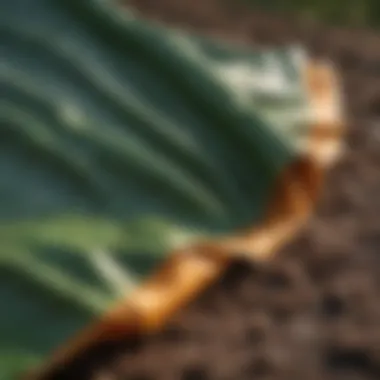
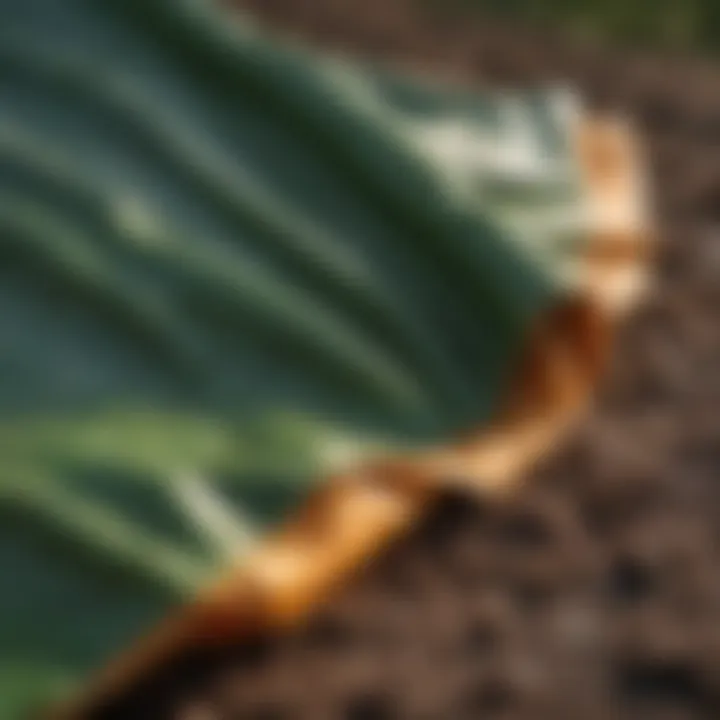
Ultimately, understanding the sustainable attributes of tarp materials can lead to a balance between functionality, environmental responsibility, and effective resource use, reinforcing a commitment to sustainable practices in agriculture.
Case Studies on Tarp Material Performance
Understanding real-world applications of tarp materials is key to making informed choices in agriculture. Case studies provide insights into the effectiveness and limitations of various tarp options in diverse agricultural environments. By examining specific instances where tarps have been used in crop protection and other applications, we collect valuable data. This data helps farmers to assess which materials may best suit their needs based on experienced outcomes.
Effectiveness in Crop Protection
Crop protection is a primary concern for any farmer. Selecting the appropriate tarp can influence crop health significantly. For example, a case study conducted in California utilized high-density polyethylene tarps during an unusually rainy season. These tarps effectively protected young crops from heavy rain, reducing soil erosion and preventing waterlogging, which is detrimental to plant roots. Farmers reported a notable increase in yield and overall plant health due to this intervention.
In another instance, PVC tarps were evaluated in a tomato farm in Florida. The lightweight nature and excellent UV protection of these tarps created a microclimate that enhanced fruit development. The tarps provided shade during the hottest parts of the day, thus reducing heat stress and promoting optimal growth conditions. The farmers noticed a more uniform ripening process, leading to higher quality produce.
Such case studies highlight that the effectiveness of tarp materials in crop protection depends on the specific climatic conditions and the type of crops being grown. It is clear from these examples that understanding local conditions plays a crucial role in the selection of suitable tarp materials.
Challenges Faced with Different Materials
Despite the advantages, there are challenges associated with each tarp material. A case study in the Midwest examined the use of canvas tarps for shielding winter crops. While the durability of canvas was beneficial, issues with moisture retention led to fungal growth, affecting crop yield. This case emphasizes the need for farmers to weigh the pros and cons of each material based on their context.
Similarly, another case in Texas addressed the challenges of using fabric tarps. Although these tarps are lightweight, they struggled against strong winds, which led to shifting and even tearing. Farmers found that extra anchors were required, increasing labor costs and time.
It is essential to note that every material has its strengths and weaknesses. Farmers must conduct their evaluations and consider factors like local weather patterns, crop types, and their specific operational context.
Case studies offer practical insights, revealing the nuanced performance of tarp materials in varied agricultural settings.
Through these discussions of effectiveness and challenges, the article can present a detailed overview, allowing readers to make better decisions regarding tarp materials for their agricultural practices.
Finale
In the context of this article, the conclusion synthesizes vital insights into the selection of tarps for agricultural purposes. It is essential to understand that the material choice can significantly affect farming success. The performance of tarps influences crop protection, manageability during installation, and durability against weather conditions. Considering the environmental implications of tarp materials also plays a crucial role in sustainable farming practices. Farmers must weigh each tarp’s strengths and weaknesses tailored to their specific needs, acknowledging that an informed decision can lead to improved agricultural outcomes.
Recap of Key Points
- Material Properties: Different tarp materials, such as polyethylene, PVC, canvas, and fabric, exhibit varied strengths and weaknesses. It’s important to evaluate which characteristics align with particular agricultural challenges.
- Durability and Water Resistance: Tarps need to withstand harsh weather elements while effectively protecting crops. Choosing a long-lasting and water-resistant tarp ensures better protection.
- Environmental Sustainability: The increasing focus on eco-friendly practices signifies the necessity of selecting sustainable materials. Understanding the lifespan and recyclability of tarp options is critical.
- Practicality & Usability: The ease of installation and handling should also be considered when selecting tarps, particularly for farmers who may work solo or with limited assistance.
Final Recommendations for Farmers
To make a well-informed tarp material choice, farmers should:
- Assess Specific Needs: Review individual farming practices, climate conditions, and crop types to determine which tarp material best meets their requirements.
- Prioritize Durability: Opt for materials with proven durability in agricultural settings to minimize replacement needs.
- Consider Sustainability: Evaluate eco-friendliness and recyclability to align with modern agricultural practices focused on sustainability.
- Budget Accurately: While cost is important, investing in higher-quality tarps can save money in the long run due to reduced replacements and better protection.
"The right tarp can be a farmer's silent guardian, preserving both crops and the land's integrity."
Each of these considerations will help farmers to choose the appropriate tarp materials, ultimately leading to better outcomes in their agricultural activities.



